|
Home
::
Overhand Throw Clinic
|
Overhand Throw Clinic
|
Throwing Clinic |
|||||||||||||||||||||||||||||||||
|
Does your arm hurt?
Read the following and maybe you'll understand why !!! |
|||||||||||||||||||||||||||||||||
|
The purpose of this page is to educate coaches/players/parents the proper and improper movement of an arm on
an overhand throw. For questions and comments, please e-mail or call: 425-591-7612 anytime. |
|||||||||||||||||||||||||||||||||
|
This Months Topics:
|
|||||||||||||||||||||||||||||||||
| Valgus Stress- VERY IMPORTANT | The Unintentional Slider | ||||||||||||||||||||||||||||||||
| The Overhand Throw | |||||||||||||||||||||||||||||||||
|
|
|||||||||||||||||||||||||||||||||
|
In January, we attended the American Sports Medicine Institute Injuries Course held in Phoenix, AZ.. We were the only "training aid" company invited to attend which obviously spoke volumes about the ThrowMAX and it's potential to cure throwing mechanics people face everyday. |
|||||||||||||||||||||||||||||||||
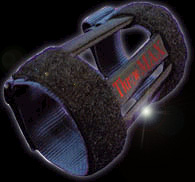 |
|||||||||||||||||||||||||||||||||
 |
 |
||||||||||||||||||||||||||||||||
|
To understand specifically how these problems develop, one must have a general idea of the dynamics of an overhand throw.
|
|||||||||||||||||||||||||||||||||
|
The overhand throwing motion for a baseball/softball is similar to throwing a football but not the exact same (biggest differences seen in the elbow joint). To truly understand overhand throwing, one must look at the motions in their most basic forms. Most sports medicine physicians divide the overhand throw into 5 basic movements:
For ThrowMAX purposes, we will briefly examine the cocking, acceleration, and deceleration stages... |
|||||||||||||||||||||||||||||||||
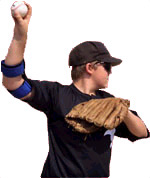 |
|||||||||||||||||||||||||||||||||
|
Early Cocking/Late Cocking In the beginning of an overhand throw, the cocking of the arm can often determine the arm slot a thrower will use (arm slot is the path of the arm from the beginning of the throw until its conclusion). If the arm is put into anything besides the high-cock position (as shown to right) then the elbow is usually below the shoulder and can cause a mechanically incorrect throw leading to injury. |
|||||||||||||||||||||||||||||||||
|
Acceleration At the point where the arm reaches maximal acceleration with forearm bent back literally being "dragged" by the bicep/tricep, the elbow joint begins to extend and the shoulder rotates to |
|||||||||||||||||||||||||||||||||
| 138 degrees. During this part of the throw, the elbow joint begins to experience valgus stress (see Valgus Stress for details). Essentially, what is going on is that the elbow is the only part of the body holding on to the forearm and the components of the elbow (ligaments/tendons/etc) are not extremely strong areas of the human arm - younger players are especially susceptible to high biomechanical forces because of the lack of dynamic strength/stability. | |||||||||||||||||||||||||||||||||
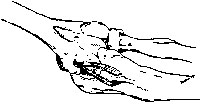
The chest contributes greatly to arm speed. When the elbow begins the "drag" the forearm and the shoulder internally rotates counterclockwise, the chest/hips/abdominals. This is the fastest human body motion we are capable of. It is also a very violent activity with tremendous kinetic energy that can cause soft-tissue trauma or even bone breakage. |
|||||||||||||||||||||||||||||||||
|
Valgus Stress Valgus stress is experienced by a thrower at both the Acceleration and Deceleration stages of a throw. It is the amount of force generated on the elbow joint. Too much force on the joint leads to the tendentious, tennis elbow, rotator cuff, and UCL issues. With the acceleration of the arm moving forward, causes the forearm to drop back and be "dragged" behind the rest of the arm. The forearm moves back because of this force generated and because the the internal rotation (counter-clock wise) of the ball and socket joint in the shoulder. The arm basically looks like it lays flat and |
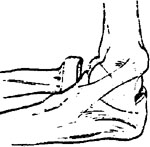 |
||||||||||||||||||||||||||||||||
|
gives the body a very distorted appearance. It is important to understand that the weakest point in the arm is the elbow area which is why that is where the most injuries take place. The shoulder is the second weakest area and when a players "arms" a throw, they exert unusual amounts of pressure on these two locations. |
|||||||||||||||||||||||||||||||||
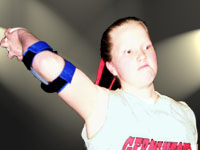 |
|||||||||||||||||||||||||||||||||
|
For deceleration, the elbow experiences extreme "pulling" forces when the arm commences on its follow-through and is dragged down or across the body. If the body is not used in the throw, the arm takes the bulk of the force because the energy is not dissipated back to the trunk and the elbow is the only area holding the arm together - this is often called forced extension. ***NOTE - With the ThrowMAX, a player can only put the throwing arm in the high-cock position and has to use the proper arm slot which brings valgus stress to a minimum. |
|||||||||||||||||||||||||||||||||
|
The Unintentional Slider - "tail at the end of every throw" There are several arm motions players use when throwing a ball (see baseball or softball works page) - often in varying combinations. 1) Elbow below and in front of the shoulder 2) Elbow below the shoulder and the hand near the ear 3) Elbow above the shoulder and the hand near the ear All three common arm motions are wrong. A player cannot throw accurately or with distance using the first two. The third motion can injure a player's arm with the snapping motion required to throw hard or with distance. This third motion is the way people used to think catchers should throw, using a cocked arm. This motion also forces the thumb on the top of the ball at the moment of release, causing the ball to spin like a slider, without the player being aware of it. A slider creates the appearance of the seams spinning in circles appearing as a dot as the ball comes towards you. This motion can be very harmful to an arm even more so than an improperly thrown curve. The reason is quite simple: the player is not aware that every throw they make is a slider. |
|||||||||||||||||||||||||||||||||
 |
|||||||||||||||||||||||||||||||||
 |
|||||||||||||||||||||||||||||||||
| Incorrectly Thrown | Correctly Thrown | ||||||||||||||||||||||||||||||||
|
The reason the thumb gets on the top of the ball is because the wrist feels uncomfortable which is why it adjusts and in turn, cases the fingers to adjust. The reason the wrist is adjusting is because the arm slot being used by the forearm and bicep/tricep (Humerus) is incorrect. The reason the armslot is wrong is because as explained earlier, if a player cocks their arm in anything but the high-cock position, the player runs the risk of making a mechanically poor throw. The key to defeating this issue is to get the hand on top of the ball by cocking the arm incorrectly and in turn, using the correct arm slot. |
|||||||||||||||||||||||||||||||||



